
A recessed sink is not only a very convenient solution but also elegant and fits well in a kitchen with modern design. That's why more and more people are opting for this type of kitchen sink installation. However, the installation of this type of sink must be done very precisely; otherwise, it will not only look poor but also will not function properly. If you are not a professional in this field, it is better to seek help from someone more experienced.
Elegant undermount sink
The kitchen countertop and the regular arrangement of all necessary kitchen items allow you to create not only an elegant but also a very functional space. Worktops planned according to ergonomic principles allow for comfortable work in the kitchen. However, to ensure optimal comfort during work, the undermount sink must be installed properly.
When deciding on an undermount sink, you need to choose the appropriate countertop for it. An undermount sink is practically invisible, which is why many people choose this type of installation to fully utilize the aesthetic potential of their countertop. In the case of a drop-in sink, the countertop is partially obscured by the sink elements. However, with an undermount sink, it does not extend even a bit above the edge of the countertop.
.jpg)
How to install an undermount sink?
Undermount sinks allow for achieving a seamless surface with the countertop; however, to achieve this, it is essential to seek help from a professional. It is best to make the decision about installing an undermount sink before purchasing the countertop, that is, during a major renovation or when outfitting a new apartment. This type of sink is placed in a specially cut opening in the countertop, so the appropriate thickness of the countertop is very important. For composite countertops, it can be from 0.6 cm, while with stone countertops, it is about 2-3 cm. Wooden and laminate countertops can be thicker, even up to 7 cm. We will talk a little later about which countertops are suitable for combining with an undermount sink.
The first step is to cut an opening in the kitchen countertop corresponding to the size of the undermount sink. It is advisable to entrust the task of cutting openings to someone who knows what they are doing and has the appropriate equipment. This is especially important when we are discussing a granite countertop or one made from sintered stone. Only with perfectly polished edges will everything be ideally fitted. Next, the sink should be placed on the countertop "upside down"; after securing the sink to the countertop, silicone should be used to seal the connection areas. The next step is to flip the countertop with the sink to the correct position and install the siphon and faucet in it. As you can see, self-installation can be significantly complicated.
Undermount sinks – which countertops?
Undermount sinks should be combined with the appropriate type of countertop; not every countertop can accommodate this type of sink, primarily depending on the material from which it is made. Experts recommend that only waterproof materials be selected for undermount sinks. Therefore, suitable options include countertops made from natural stone, conglomerate, marble, granite, or other sintered stone types. These listed materials are resistant to water infiltration, which is particularly important in the case of an undermount sink since water splashes outside the sink edges onto the countertop surface during washing. In addition, maintaining cleanliness of such materials does not pose any issues. This is an excellent solution for modern kitchens.
Due to water exposure, wooden and laminate countertops are not used for undermount sinks, as they are less resistant not only to water but also to mechanical damage. Even a well-treated wooden countertop will deteriorate over time, and mold or fungi may also appear on it. Meanwhile, laminate countertops are only waterproof on the outside; when openings are cut in them, the particle board is exposed, which can gradually become soaked, swell, and lead to damage of the countertop.


















